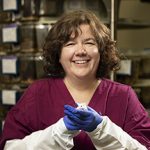Gnotobiotic Mouse Core
Gnotobiotic (germfree, defined flora) rodents have become powerful tools to advance our understanding of the host–microbiome relationship. The maintenance and, ultimately, the monitoring of gnotobiotic rodents is a critical, labor-intensive and costly process requiring specialized skills and equipment.
The necessary gnotobiology techniques and equipment were developed more than 60 years ago. However, recently, the demand for gnotobiotic animals has rapidly expanded as the significant role of the microbiome in health and disease has become a major focus of research across multiple disciplines.
OMRF’s gnotobiotic mouse core provides centralized germ-free and gnotobiotic mouse services that include large flexible film isolators for breeding and small experimental isolators for a variety of in vivo studies utilizing germ-free mice. A specialized rack of sealed positive-pressure HEPA-filtered cages allows for microbiome control at the single-cage level, which is ideal for many applications. The core provides rederivation services for generating customized germ-free and gnotobiotic mouse strains, allowing for the study of the interaction of a gene of interest with the microbiome. The core provides technical support to investigators for numerous experimental procedures.
Services
Caesarean rederivation — to create germ-free mice from existing SPF mouse lines
Isolator setup and maintenance for dedicated projects
Experimental study support
Technical procedures




